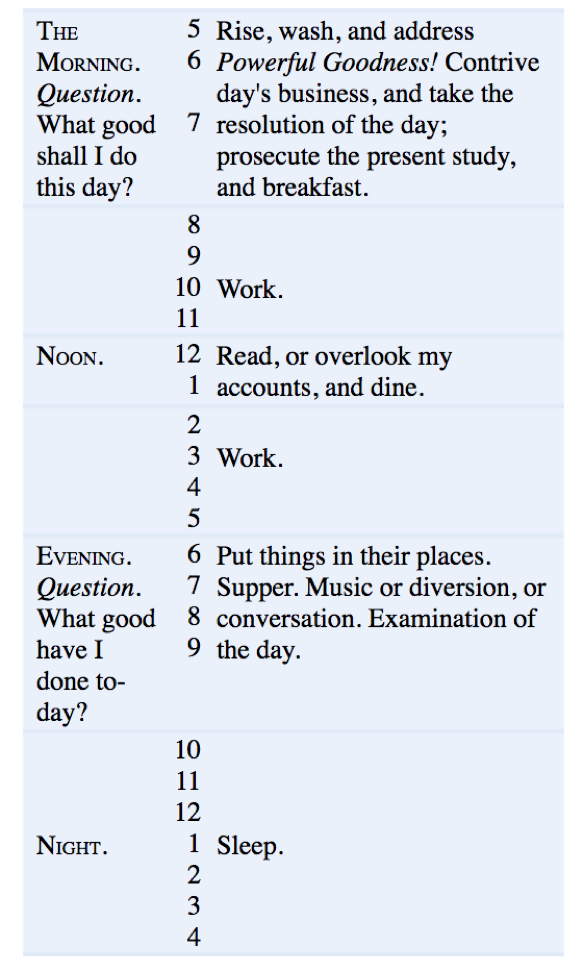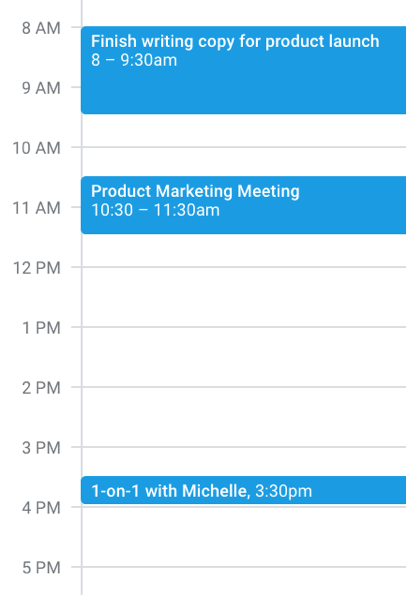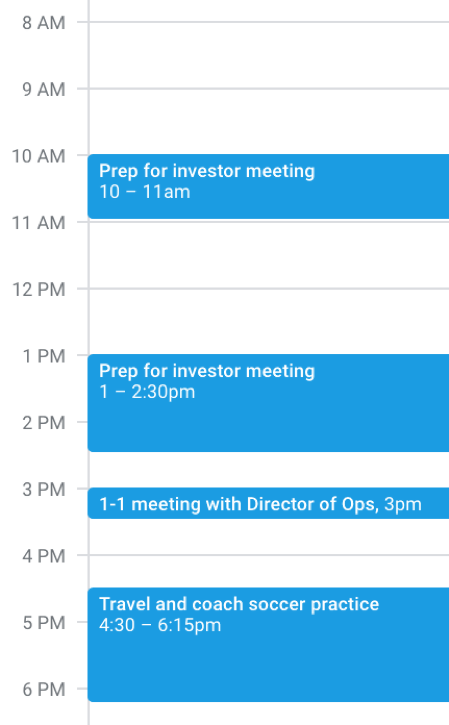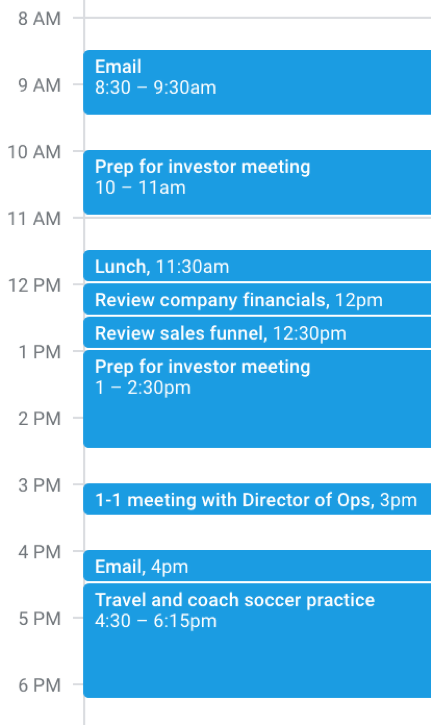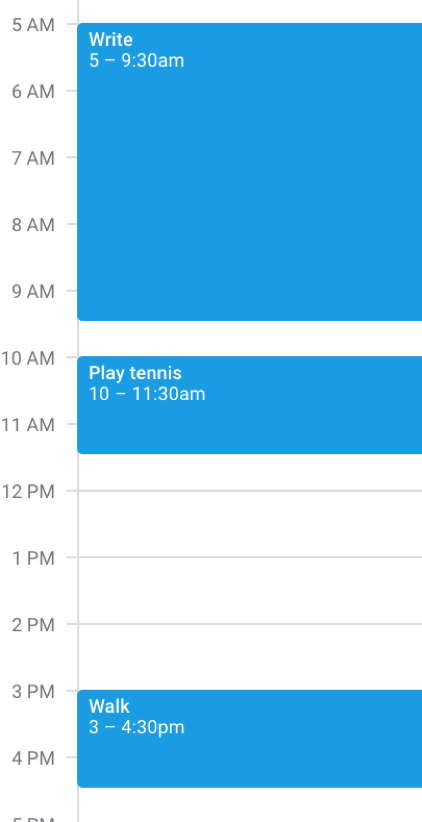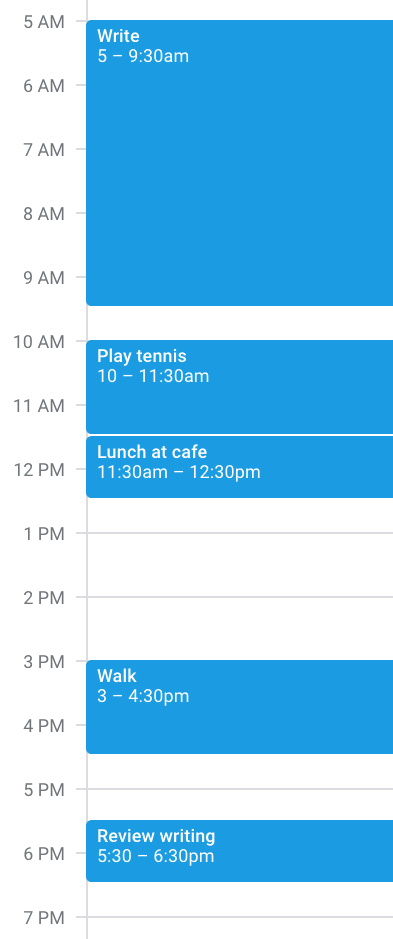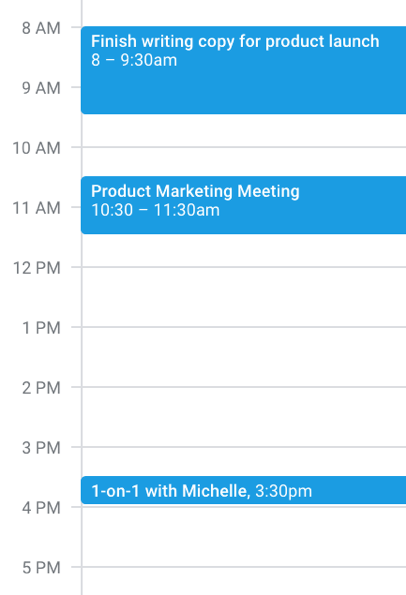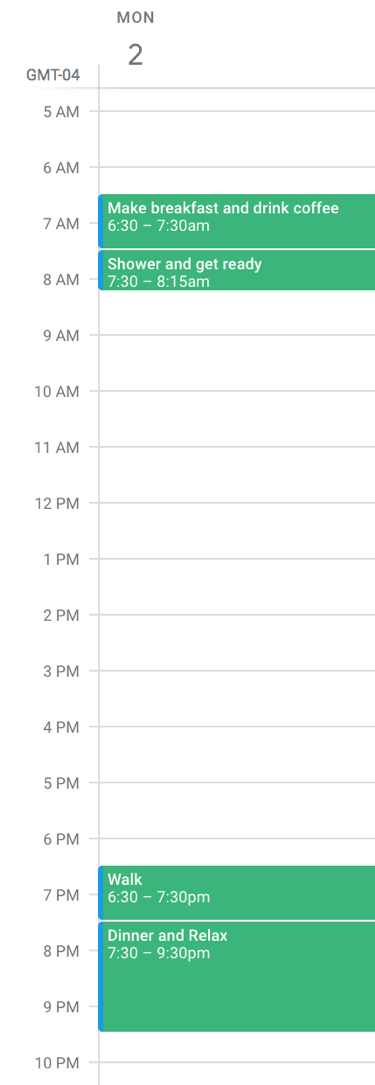Audiobook Reference Guide
The Purposeful Planning Method
How to Plan Your Day, Beat Procrastination, and Regain Control of Your Time
Copyright © 2019 by Matthew C. East
All rights reserved.
The Purposeful Planning Book Series by Matt East
The next book is coming!
The Purposeful Planning Manifesto, delivers a motivational plea for you to begin each day with focus, intention, and a plan to accomplish your goals. It urges readers to take more action, pursue their dreams, and begin each day with possibility.
Be the first to know when it’s released…
CHAPTER THREE
Why Does This Method Work So Effectively?
“The greatest happiness is to transform one's feelings into action.”
— Madame de Stael
The Purposeful Planning Method relies on two time-tested and straightforward concepts to ensure you plan each day effectively:
Prioritizing what you want to focus on each day is critical to your success.
Embracing positive habits into your daily routine is the most effective way to ensure you achieve what you want.
Those two concepts are the backbone of everything we'll discuss in this book. Let's touch on why each is so important.
Prioritizing is critical to our success because it helps ensure we intentionally focus on our most important projects, activities, and relationships throughout the day. Having clarity about our priorities is one way to ensure we’re thoughtful and effective with our time. And, behavioral scientists suggest our habits consume 40 percent of our day. This means being intentional about our habits can help ensure we use our time as purposefully, meaningfully, and productively as possible.
Of course, you didn't need to read this book to learn how prioritizing your time and creating good habits will help you be more productive. Although we know each of these is critical to our success, it can be a challenge to do them. And that's why this book is vital to your success. It provides a method to follow each morning to ensure you start each day with clear priorities and intentional habits.
I mentioned the intent of this book isn't to convince you how important it is to plan your day. After all, you already chose to read a book titled, The Purposeful Planning Method. This means you recognize planning is essential to your success. However, as you adopt this method, you may still interact with colleagues, friends, and family members who might try to minimize how necessary planning is. Be cautious about accepting advice from these people. If you encounter anyone who downplays the importance of planning, consider the level of success they have attained in their life before taking their advice. The truth is, planning and prioritizing is key for anyone who is looking to maximize their potential. I strongly encourage you to speak with as many successful people as you can to discover how they plan their time. Connecting with these high performers will only reinforce how critical planning and prioritizing is to your success.
Most people reading this book already understand how planning can help them be more productive at work. And it can definitely do that. But its benefits reach far beyond work. Remember, the purpose of using this method is not to do more stuff just for the sake of doing more. It's the opposite. The aim is to help you identify what is most important to you each day so you can plan how you want to use your time.
Beyond work, use this method to:
Reach your peak level of health and fitness
Dedicate more time to your meditative or spiritual practice
Get out of debt and create financial abundance in your life
Spend more time and be more present with your family
Nurture valuable relationships and friendships
Relax and enjoy your leisure time more
Have a thriving marriage
Or use it for any activity you choose. There are no limitations.
This method uses a proven scheduling technique called time blocking. Time blocking allows you to proactively assign blocks of time to complete tasks throughout the day.
The world’s most successful people have practiced time blocking for centuries. Ben Franklin, an entrepreneur, author, and a signer of both the Declaration of Independence and The American Constitution, used a block schedule to structure his day. Franklin shared his block schedule in his autobiography, and shared, "Every part of my business should have its allotted time." [1]
You can view Franklin’s block schedule in Image 1. Audiobook listeners can find this in the accompanying PDF within the Audible app, or you can easily find these examples online on my website at www.matt-east.com/book.
Image #1
In addition to using the proven practice of time blocking, The Purposeful Planning Method leverages habit creation and routine development to perform at your peak. By embracing these techniques, you'll be using the same daily practices as the most successful people in the history of the world.
Examples include:
Richard Branson, the founder of Virgin and a self-made billionaire, provides a great example of time blocking. Branson blocks time on his calendar to ensure he exercises daily. He says, "I play a very hard game of singles tennis every morning at 6." [2]
The media icon and philanthropist Oprah follows the same daily routine upon waking. "First thing in the morning, I brush my teeth and take the dogs out." Then she completes "a series of spiritual exercises that I do every day. Then I meditate." [3]
According to Walter Isaacson, author of the biography, Steve Jobs, "Steve had an evening routine where he would come home and sit at a nice long wooden table in the kitchen of his house in Palo Alto to eat dinner every night with his kids and his great wife." [4]
In The Open Road: The Global Journey of the Fourteenth Dalai Lama, the author Pico Iyer shares, "[By] nine a.m. the Dalai Lama himself had already been up for more than five hours, awakening, as he always does, at three-thirty a.m., to spend his first four hours of the day meditating." [5]
Other successful people known for relying on their daily routines to create an extraordinary body of work include:
Best-Selling Authors—Maya Angelou, Haruki Murakami, Kurt Vonnegut, Ernest Hemingway, E.B. White, and Stephen King are known for the commitment to their routines.
King famously writes every day of the year without exception beginning work between 8 a.m. and 8:30 am.
Championship Athletes—Usain Bolt, Messi, Michael Jordan, Novak Djokovic, Carli Lloyd, and Tom Brady use game-day rituals and daily habits to perform at their peak.
In his book, Brady shares the following, "To create stronger, faster connections in our brains, we need to practice a habit, skill, or behavior again and again. The more we practice that habit, skill, or behavior, the more automatically our brains recognize it."
Beethoven, one of the greatest composers of all time, and Pablo Picasso, one of the most influential artists of the twentieth century, were both recognized for their commitment to process and routine to ensure their creativity.
Picasso said, "Our goals can only be reached through a vehicle of a plan, in which we must fervently believe, and upon which we must vigorously act. There is no other route to success."
I particularly love this quote because there is a misconception that creative disciplines don't require structure and planning. However, in most instances, you'll find the world's greatest creators are reliant on habits and routines during their most prolific periods.
Nelson Mandela, a beloved political leader and former President of South Africa, was well-known for his commitment to his daily workout throughout his life.
In his autobiography, Nelson says, "I attended the gym for one and a half hours each evening from Monday through Thursday. We did an hour of exercise, some combination of roadwork, skipping rope, calisthenics, or shadow boxing, followed by fifteen minutes of bodywork, some weightlifting, and then sparring."
These are just a few examples of extraordinary people who used routines and habits to achieve great things. The Purposeful Planning Method doesn't try to reinvent the wheel. It leverages the exact principles these leaders used to achieve incredible results. If there is a well-known person whose work you admire, I encourage you to learn more about their habits and daily routine. A simple Google search will do the trick.
I also asked clients for their feedback about why The Purposeful Planning Method works so effectively, and here is some of the feedback I received:
"I love planning this way because it ensures I'm proactive instead of reactive with my time. It ensures I take action on what's most important to me.” — Elise
"I've noticed by having a clear plan of attack for my day, I feel less overwhelmed. I have a plan for my day, but I also have a plan for when unexpected things pop up throughout the day. I feel in complete control of my time." — Mica
"Using this method has completely ended my tendency to procrastinate. Beginning my day with a plan and clarity about what I'm focusing on makes it so much easier to take action throughout the day." — Tobias
"This approach has allowed me to do activities around my energy pattern. This helps me align my peak energy with my daily writing and allows me to write more each day." — David
"Prioritizing leisure and time with my family has been a game-changer for me. I feel much more connected with my family, zero guilt when I'm relaxing, and I'm no longer burned out on my business." — Andrea
In the following chapters, you will learn exactly how to use The Purposeful Planning Method. As you reflect on your schedule, I encourage you to approach it as a self-experiment. You will see positive results immediately after adopting this method; you can use the 10-Day Challenge later in this book as a guide to get started. Enjoy the daily planning process; designing how you will spend your time each day should be a rewarding and pleasant experience. Embrace it and remove any pressure you've put on yourself. We're going to be striving for progress—not perfection—as we begin. Remember, there is zero downside to planning your time more effectively. But the benefits are endless, so stick with it. It will positively impact every aspect of your life. And remember, anyone can successfully use this method.
Chapter Recap
The Purposeful Planning Method relies on two time-tested and straightforward concepts to ensure you plan each day effectively:
Prioritizing what you want to focus on each day is critical to your success.
Embracing positive habits into your daily routine is the most effective way to ensure you achieve what you want.
Prioritizing is essential to our success because it ensures we intentionally focus on our most important projects, activities, and relationships throughout the day. Being intentional about our habits ensures we use our time as purposefully, meaningfully, and productively as possible.
The Purposeful Planning Method leverages the same principles used by the most accomplished and successful people to ever live.
CHAPTER FOUR
The Fluid Layer
“Tell me, what is it you plan to do with your one wild and precious life?”
— Mary Oliver
As I mentioned earlier, The Purposeful Planning Method uses two layers for planning your day:
The Fluid Layer
The Habit Layer
The Fluid Layer ensures we plan and schedule time for our most important priorities and tasks each day. It helps us determine what to focus on before the day begins.
Remember the ideas in this book build on one another, so for now, just focus on the concepts without worrying about implementing them. We’ll start by using the 10-Day Challenge later in the book.
I shared previously how your priorities are areas of your life that are important and meaningful to you. Priorities include projects you're focusing on at work or home, activities you want to do, or relationships you want to nurture. You achieve your priorities by completing actionable tasks associated with them.
In Getting Things Done, author David Allen shares how important it is for our tasks to be actionable. Actionable tasks are things we can do that will move us closer to achieving our priorities. Using actionable tasks to build your Fluid Layer helps your day flow smoothly from one activity to the next. For example, here are priorities and actionable tasks that could be associated with them.
Your priority may be to spend more time with your wife. The actionable task associated with it could be to make a reservation at your favorite restaurant for a date.
Or your priority may be to grow the revenue of your business. The actionable task could be to text or call ten prospective customers.
Maybe your priority is to stay in touch with your parents. The actionable task may be to call your mom or dad.
Creating your Fluid Layer includes three steps:
Determine what your priorities are for the day.
Identify the actionable tasks associated with accomplishing those priorities.
Block the time on your calendar to do your actionable tasks.
To build your Fluid Layer, you start by identifying your top three priorities for the day. Here are eleven guiding questions to help identify your priorities:
If I could only achieve one thing today, what would it be?
What’s the second most important thing I need to accomplish?
What’s the third most important?
What else needs to be done?
What could I complete today that would make me happy when reflecting on my day?
What can I do that will move me closer to achieving my goals?
Are there projects or tasks that others own but I should follow up on?
What key relationships in my life need my energy today?
What can I do to remove stress from my life?
What tasks can I delegate to someone else today?
Is there a task I’m avoiding that I should complete today?
After determining your priorities, you’ll identify the actionable task or tasks associated with each one and assign a time on your calendar for completing it.
A few important things to keep in mind when creating your Fluid Layer.
Tasks often take longer than we estimate, so you’ll want to block plenty of time to complete each task. I often find tasks take twice as long as I expect. Psychologist call this phenomenon The planning fallacy, and it explains how people tend to significantly underestimate how much time is required to complete a task. [6]
Build in open time blocks for unexpected tasks to arise throughout the day.
Most people tend to overestimate the number of tasks they can achieve in a single day. Don’t get discouraged. Planning your day is a skill, and you will continue to improve with practice.
Align your daily priorities with your broader career, business, and life goals whenever possible. This ensures your daily actions are moving you closer to your goals.
The top priority for the day will not always be the first task you schedule. For example, your top priority may be attending a one-on-one meeting with your boss at 4 p.m., but since it’s late in the day, it may be one of the last things you do.
Always start with blocking time for your top three priorities. After adding these, add any additional priorities you want.
I asked one of my clients, Eli Chastain, how prioritizing has helped him. He shared with me, “At this point, I can’t imagine a morning without time to prioritize and plan what I intend to make of my day. This simple act, every morning—before kids, before fitness, before emails, and before work—has helped me find meaning in the simplest acts. Finishing a huge project has the same accomplished feeling for me as taking my daughter to a movie, all because I decided that morning that each experience was important and worthy of my attention. This brings richness and meaning to everything I do, big and small. It all matters.”
Let's explore three Fluid Layer examples. Each is from a client I collaborated with. The examples first show their top three priorities for the day. Then the actionable tasks associated with those priorities, and last, the blocked time on their calendar.
The examples use Google Calendar, which is free with any Gmail account. However, you can use any electronic calendar or pen and paper for creating your Fluid Layer.
Fluid Layer Example 1: Corporate Professional
This example is from a marketing director who works from home for a Fortune 500 company. Her top three priorities for the day:
Finish creating copy for a product launch
Attend a product marketing meeting
Attend a one-on-one meeting with Michelle
To accomplish her top three priorities, she blocks time from 8 a.m. to 9:30 a.m. to finish writing copy for the product launch. From 10:30 a.m. to 11:30 a.m., she blocks time to attend the product marketing meeting, and from 3:30 p.m. to 4 p.m., she blocks time for her one-on-one meeting with Michelle.
You can view her schedule in Image 2.
Image #2
In addition to her top three priorities, she also wants to:
Run
Eat a quick lunch
Respond to emails throughout the day
Prep for her one-on-one meeting with Michelle
Keep time blocks open for unexpected tasks and items that arise during the day
To schedule time for each of these, she blocks the following time:
Email from 9:30 a.m. to 10 a.m., run and shower from 12 noon to 1:30 p.m., lunch at from 1:30-2:00, respond to email from 2 p.m. to 2:30 p.m., prep for her one-on-one with Michelle at 3 p.m., and respond to more email from 4:30 p.m. to 5 p.m.
She also left four, thirty-minute blocks open for unexpected tasks or to use for last-minute requests or meetings.
I love this example because she does a great job of proactively blocking time to process her email and for unexpected items to arise during the day. You can view her schedule in Image 3.
Image #3
Fluid Layer Example 2: CEO
Below are the three top priorities for a CEO of a sixty-person tech company:
Meet one-on-one with the director of operations
Prepare for a meeting with a potential investor
Coach her daughter's soccer practice
To accomplish her top three priorities, she blocks 10 a.m. to 11 a.m. and 1 p.m. to 2:30 p.m. to prep for the investor meeting; from 3 p.m. to 3:30 p.m., she blocks time to meet with the director of operations; and from 4:30 p.m. to 6:15 p.m., she blocks time to travel to and coach soccer practice.
Notice she has multiple time blocks for a single priority: "Prep for investor meeting." You can view her schedule in Image 4.
Image #4
Also, she wants to:
Check and send email
Keep plenty of time open for unexpected tasks and items
Review company financials
Review the sales funnel
Eat a quick lunch
To accomplish these priorities, she blocks time for email from 8:30 a.m. to 9:30 a.m. and from 4 p.m. to 4:30 p.m., lunch from 11:30 a.m. to 12 noon, from 12 noon to 12:30 p.m. to review company financials, and from 12:30 p.m. to 1 p.m. to review the sales funnel.
She also left four, thirty-minute blocks for unexpected tasks or to use for last-minute requests or meetings.
I shared this example because I love how she prioritizes leaving work at 4:30 so she can coach her daughter's soccer team. You can view her schedule in Image 5.
Image #5
Fluid Layer Example 3: Author
Below is an example of an author; her top three priorities are:
Write 1,000 words
Play tennis
Take a long walk
To schedule time for her top three priorities, she blocked time to write from 5 a.m. to 9:30 a.m., play tennis from 10 a.m. to 11:30 a.m., and walk from 3 p.m. to 4:30 p.m.
You can view her schedule in Image 6.
Image #6
Also, she wants to:
Have a large block of free time
Eat lunch at a café
Review her writing for an hour in the evening
To accomplish each of these, she blocks time for lunch from 11:30 p.m. to 12:30 p.m., she left 12:30 p.m. to 3 p.m. open for free time, and she blocks an hour in the evening to review her writing starting at 5:30 p.m.
I chose this example because I love how this client built large blocks of free time and multiple exercise sessions into her day. You can view her schedule in Image 7.
Image #7
In the three examples, note how each person:
Determined what their top priorities were for the day
Identified the actionable tasks associated with accomplishing their priorities
Blocked the time on their calendar to do the actionable tasks
Sometimes clients feel creating a Fluid Layer isn't possible for them or it won't help in their specific situation. Let's address a few common concerns.
Objection 1: It takes too much time and effort to plan my day.
This is a misconception. It takes about seven minutes on average for my clients. Consider the reward of approaching your day with a clear plan versus winging it. Planning your day is the most important thing you can do to ensure your success, and it takes less than seven minutes.
Each morning, I ask my clients to send me their top three priorities for their day. I then send back encouragement and often ask how the previous days' priorities went. It's an excellent system for accountability. The possibilities of what my clients prioritize are endless. Here are some recent examples:
Turn off my phone for thirty minutes of uninterrupted play with my kids
Take a meandering two-hour walk with my wife
Meditate for five minutes
Start writing the book I've been thinking about for the past ten years
Learn to speak Spanish
Read a good book while sipping on wine
Attend yoga class
Fly to India from New York
Consider what you could be prioritizing during your day. Prioritizing your time is impactful because it allows you to be intentional and proactive about what you want to do. It's a missed opportunity if you're not planning your day because you think it takes too long. It's one way to ensure you’re spending time on activities you want to be doing. The truth is planning your day requires a minimal investment of time.
Objection 2: My work is repetitive and doesn't require prioritizing my tasks.
People who have little flexibility or input about how they spend their time at work often believe prioritizing their time isn't necessary. Many positions within retail and logistics fall into this category since the workflow is primarily dictated by reacting to customer needs or reoccurring tasks.
However, remember, setting your priorities is about planning to do things that are important and meaningful to you. Even if your work is repetitive, you still have things that you want to accomplish or maintain while at work.
For example, you could focus on your health by prioritizing drinking plenty of water or eating a healthy lunch. Or you could prioritize your work performance. That's the beauty of prioritizing. What you choose to focus on is up to you. If you've never prioritized your time, establishing your priorities for the first time will be empowering because it encourages you to consider what's most important to you.
If you work eight hours a day and sleep eight hours a day, you still have eight hours to prioritize outside of work. That's a massive amount of time. Sometimes when I mention this, people argue that after commuting to work, they have far less than eight hours available. So, let's cut that eight hours in half. If you work twelve hours a day and sleep for eight hours, you still have four hours. That's a significant chunk of time, even if your work and commute take fourteen hours, and you sleep for eight hours, you still have two hours to plan and prioritize. If you're in this situation, isn't it crucial to be hyper-focused about how you spend your time during those two hours?
The truth is, planning your day is critical for your success, regardless of the type of work you do.
Objection 3: My schedule varies too much from day to day.
A varying schedule is not a reason to skip planning your day. If you don't plan, it's tempting to get distracted by nonimportant items, which quickly leads to unfocused work and using your time ineffectively. Not prioritizing increases the chance of getting sidetracked by unmeaningful things and leads to procrastination.
The truth is, if your schedule varies day to day, you must plan your time if you want to be as effective as possible. By successfully planning, you approach each day with clarity, purpose, and focus.
Objection 4: I have too many "urgent" tasks I need to respond to throughout the day, so I can't plan my time.
All of us need to adapt to requests and demands throughout the day. Nobody wants to tell their boss they can’t get that urgent fix out today because it's not on their calendar. If it's common for you to respond to urgent items throughout the day, build in plenty of time for responding to these requests. You can also reprioritize your time and calendar to focus on these urgent tasks as they arise throughout the day.
However, if you tend to have many dramatic events happen during a typical day, develop new processes to minimize the number of these events from disrupting your workflow. Responding to urgent tasks can lead to feeling anxious and stressed out. Beginning your day with a plan is the best way to bring focus and clarity to your work, and that's the easiest way to combat feeling overwhelmed. The truth is, prioritizing your time will help you be more organized and focused, ultimately increasing your responsiveness and decreasing your stress level.
Objection 5: I'm not good at estimating how long tasks take.
Most people tend to underestimate how much time is required to complete a task. This is normal. People tend to be optimistic about how much they can achieve in a specific timeframe. Remember this is so common, psychologists have a name for it, the planning fallacy.
It can be disheartening, frustrating, and stressful when tasks take too long. We can combat this by understanding it’s common and blocking more time for our tasks.
The truth is, everyone feels this way, and it should not stop you from planning your day. You will learn to more accurately estimate how long tasks take as you continue to prioritize daily.
Objection 6: I'm worried I'll lose sight of my long-term goals by focusing so much on my plan for each day.
Your Fluid Layer should act as a lever for achieving your long-term goals. Your priorities should support and align with your long-term goals whenever possible. A personal example would be creating this book. One of my goals was to write a book. Instead of hoping that happened, I prioritized time to write each day. If I hadn’t prioritized time to write, I would have never achieved my goal.
The truth is, prioritizing your time each day will help you achieve your long-term goals faster.
Objection 7: I'm concerned prioritizing will reduce my creativity.
Planning supports your creative endeavors by giving you consistency and structure to create your art. It's a misconception artistic disciplines don't require planning. The truth is, the most prolific creators understand how to use habits, routines, and planning to increase their creative output.
Chapter Recap
The Fluid Layer helps us plan and schedule a time for our most important priorities and tasks each day. The purpose of the Fluid Layer is to ensure we're intentional with our time and energy. You can prioritize anything important and meaningful to you. Priorities often include projects you're focusing on at work or home, activities you want to do, or relationships you want to nurture. And sometimes, priorities are things that must be done. Like paying bills—these types of items aren't always fun, but they are important. You achieve your priorities by completing actionable tasks associated with them.
You'll learn how to create your Fluid Layer during the 10-Day Challenge. In the next chapter, we'll learn how to create your Habit Layer.
CHAPTER FIVE
The Habit Layer
“A day dawns, quite like other days; in it, a single hour comes, quite like other hours; but in that day and in that hour, the chance of a lifetime faces us."
— Maltbie Davenport Babcock
The Habit Layer is the second and final layer we’ll use to plan our day. It uses your habits and routines to ensure each morning and evening is proactively structured to be as productive and meaningful as possible. Unlike the Fluid Layer, which changes daily, the Habit Layer remains consistent from week to week.
While the Fluid Layer ensures you intentionally prioritize what’s most important to you, the Habit Layer ensures you plan your mornings and evenings successfully. According to Duke University research, habits account for approximately 40 percent of our daily behaviors. [7] The Habit Layer encourages you to be intentional and proactive with this significant portion of your day.
Remember, we’ll use the 10-Day Challenge to create your Habit Layer, so for now, focus on absorbing the ideas and concepts of this chapter without worrying about implementing them.
In addition to ensuring you’re intentional with how you spend your morning and evenings, the Habit Layer will assist you in creating the habits you want.
One benefit of this layer is that it reduces the number of decisions you’re required to make each day, which reduces the chance you’ll be negatively affected by decision fatigue. Decision fatigue occurs when we have too many options to choose from; abundant options often lead to feeling overwhelmed, procrastination, and a decline in our decision making. By determining what to focus on, we increase the chance to do what we desire.
Here’s a personal example of how it works. I use my Habit Layer to go to the gym every morning, by making this decision when initially creating my Habit Layer. I never have to spend energy thinking about it again. This allows me to avoid contemplating what I should do each morning. Going to the gym each morning has become a habit. I wake up, make coffee, feed the dogs, grab my gym bag, and head out. One reason I’ve been able to maintain this habit is that I love ending my workout with a relaxing sauna session. This visit to the sauna acts as a reward to encourage my daily habit loop.
Charles Duhigg shares how habit loops work in his book, The Power of Habit. The Habit Loop is a neurological loop that governs any habit. The loop consists of three elements: a cue, a routine, and a reward. Understanding these elements can help to change bad habits or form better ones.
The cue
The cue for a habit can be anything that triggers the habit. Cues generally fall under the following categories: a location, a time of day, other people, an emotional state, or an immediately preceding action.
The routine
A habit's routine is the most obvious element. It's the behavior you wish to change or reinforce (such as going to the gym).
The reward
The reward is the reason the brain decides the previous steps are worth remembering for the future. The reward provides positive reinforcement for the desired behavior, making it more likely you will produce the behavior again in the future. The reward can be anything, from something tangible (chocolate) or something intangible (a sauna session).
In addition, creating your Habit Layer:
Helps create awareness of your daily habits and rituals
Reduces procrastination by creating clarity about how you want to spend your time
Ensures you’re proactive about your morning and evening routines
Helps you pursue your passions by proactively blocking time for the activities you want to do
Enriches your relationships by planning time for nurturing them
Enables you to enjoy your leisure time more
Clients regularly use the Habit Layer for the following activities:
Running
Walking
Resistance training
Drinking coffee or tea
Practicing yoga
Going to the gym
Building a daily writing practice
Meditating
Planning and reflecting on the day
Journaling
Working on a side business
Cooking breakfast or dinner
Spending time with family and friends
Going on date nights
Reading
In addition to his morning tennis game, Richard Branson includes other exercises, breakfast, and family time during his morning routine. “I wake up early; around 5 am. I get out of bed and do some exercise – play a game of tennis, go for a walk or a run, jump on my bike, or if there’s enough wind, go for a kitesurf. Then I eat breakfast and spend time with my family. Exercise and family time put me in a great mind frame before getting down to business.” [8]
Habit expert and author James Clear shares the following tips to creating daily habits:
Start with an incredibly small habit.
Increase your habit in very small ways.
Break your big habits into small chunks.
When you slip, get back on track quickly.
Be patient. Stick to a pace you can sustain. [9]
Below are Habit Layer examples.
Habit Layer Example 1: Corporate Professional
In the first Habit Layer example, we’ll revisit the marketing director, who works from home for a Fortune 500 company. Each weekday morning, she wants to do yoga, meditate, plan her day, and shower. On the weekends, she wants to sleep in until 9 a.m.
In the evenings, she wants to spend two evenings each week with friends for dinner and the other three relaxing, preparing dinner, and reading. She wants to prepare for bed at 10 p.m. and be in bed by 10:30 p.m.
You can see how she blocked time for these in Image 8. Remember, you can easily find these images at www.matt-east/book.
Image #8 is shown above
In Image 9, you can view an example of a single day of her Habit Layer. Six a.m. to 6:30 a.m. is blocked for yoga, 6:30 a.m. to 7 a.m. is blocked to meditate and plan the day. Seven a.m. to 8 a.m. is blocked to shower and get ready. Six p.m. to 10 p.m. is blocked for dinner, reading, and relaxing. At 10:00 p.m., she begins to prep for bed. Ten-thirty p.m. to 6 a.m. is blocked for sleep.
Image #9 is shown above
In Image 10, you can see the final plan for her day with the Habit Layer (in green) and the Fluid Layer (in blue). This final schedule is: 6 a.m. to 6:30 a.m. yoga, 6:30 a.m. to 7 a.m. meditate and plan day, 7 a.m. to 8 a.m. shower and get ready, 8 a.m. to 9:30 a.m. finish writing copy for product launch, 9:30 a.m. to 10 a.m. email, 10 a.m. to 10:30 a.m. open, 10:30 a.m. to 11:30 a.m. product marketing meeting, 11:30 a.m. to 12 Noon open, 12 Noon to 1:30 p.m. run and shower, 1:30 p.m. to 2:00 p.m. eat lunch, 2 p.m. to 2:30 p.m. email, 2:30 p.m. to 3 p.m. open, 3 p.m. to 3:30 p.m. prep for one-on-one, 3:30 p.m. to 4 p.m. meet for one-on-one with Michelle, 4 p.m. to 4:30 p.m. open, 4:30 p.m. to 5 p.m. email, 5 p.m. to 6 p.m. open, 6 p.m. to 10 p.m. read, dinner, relax, 10 p.m. prep for bed, 10:30 p.m. sleep.
Image #10 is above
Common questions about the Corporate Professionals schedule.
Tuesday and Thursday are blocked to eat dinner with friends. What if a friend wants to meet on a different day, like Wednesday?
That’s no problem. If she wants to meet her friend, she can change one of her evenings out this week to be Wednesday. Or she could go out on Tuesday, Wednesday, and Thursday with friends. Making that adjustment is no problem. This isn’t called the No Fun Planning Method. The goal is to be intentional with your time. But do it thoughtfully and update the changes within your calendar.
I follow my morning Habit Block almost 100 percent of the time since scheduling conflicts early in the morning are infrequent. But my evening Habit Block typically requires an adjustment about once a week because of dinner, work, or social events with friends. It’s no big deal—simply make the adjustment on your calendar and you’re all set. You're still acting intentionally and purposeful with how you’re spending your time, which is the primary goal.
Should my Habit Layer remain the same each day? I notice this example isn’t the same each day.
It’s totally up to you. It’s your Habit Layer. I want you to be intentional all seven days of the week, but some habits like helping the kids get ready for school are only five days a week. Some people like to have a consistent habit layer for weekdays and different habits on the weekends. For instance, many of my clients want to use one or both weekend mornings to sleep longer. Many people like to keep their Habit Layer consistent for all seven days of the week. The goal is for you to be intentional and to build a Habit Layer that works well for you.
Habit Layer Example 2: CEO
The CEO wants to use her Habit Layer to prepare breakfast and spend time with her daughter before she leaves for school. She also wants to have coffee with her husband after her daughter gets on the bus. In the evenings, she wants to walk for at least an hour and then relax with her family as her husband cooks dinner. On the weekends, she wants to walk for an hour before her husband and daughter wake up.
To do this, she blocks each weekday morning from 6:30 a.m. to 7:30 a.m. to make breakfast and drink coffee, she then blocks 7:30 a.m. to 8:15 a.m. to shower and get ready. On the weekends, she blocks 6:30 a.m. to 7:30 a.m. to walk. In the evenings during the week, she blocks 6:30 p.m. to 7:30 p.m. to walk, and she has 7:30 p.m. to 9:30 p.m. blocked for dinner and relaxing.
You can see how she blocked time for these in Image 11.
Image #11 is shown above
In Image #12, you can see a single day of her habit layer. I included this because it’s easier to view the details of her schedule in this image.
Image #12 is shown above
Her final schedule with the Habit Layer (in green) and the Fluid Layer (in blue). From 6:30 a.m. to 7:30 a.m., she blocks time to make breakfast and drink coffee with her husband; from 7:30 a.m. to 8:15 a.m., she showers and gets ready. Eight-thirty a.m. to 9:30 a.m. is blocked for email, followed by an open 30-minute block of time; from 10 a.m. to 11 a.m. is blocked to prep for the investor meeting, followed by another 30-minute open block. At 11:30 a.m., she eats for 30 minutes; from 12 Noon to 12:30 p.m., she reviews the company financials, then reviews the sales funnel from 12:30 p.m. to 1 p.m. From 1 p.m. to 2:30 p.m., she blocks more time to prepare for the investor meeting. She then has 30 minutes open for responding to unexpected items; from
3 p.m. to 3:30 p.m., she meets with the director of operations, followed by another open block. She rechecks email from 4 p.m. to 4:30 p.m.; 4:30 p.m. to 6:15 p.m. is blocked for traveling to and coaching her daughter’s soccer practice. She has another open block followed by her walk from 6:30 p.m. to 7:30 p.m., and her final block is from 7:30 p.m. to 9:30 p.m. for dinner and relaxing. You can view her schedule in Image 13.
Image #13 is shown above
Common Questions about the CEO’s Habit Layer:
Dinner is planned each weeknight from 7:30 p.m. to 9:30 p.m. What if other dinner plans arise, such as meals with clients or with friends?
That’s going to happen, no doubt about it. It’s no big deal. When plans like that arise, and she wants or needs to attend, it’s important to add the new plans to her calendar. Remember, the goal is to be intentional.
How does the Habit Layer change if the CEO needs to travel for work?
It’s likely to change significantly, and that’s no problem. I would encourage her to be deliberate by planning and prioritizing her time during the trip, but maintaining her exact Habit Layer isn’t likely. I would encourage her to maintain parts of her schedule, if possible. For example, if it’s still possible to walk for an hour a day, she should keep that in her schedule while traveling.
Habit Layer Example 3: Author
Let’s build the Habit Layer for the author. She wants to wake up at 4:45 a.m., make coffee, and begin writing by 5:15 a.m. each morning. She hopes to follow the same morning and evening routine, seven days a week. In the evening she wants to cook, have a glass a wine, and always be in bed by 9 p.m.
To do this within her Habit Layer, she blocks time to wake up and drink coffee at 4:45 every morning. Each evening. she blocks time from 6:30 p.m. to 8 p.m. for cooking dinner, having a glass of wine, and relaxing. And she blocks time at 8:30 p.m. to prep for her 9 p.m. bedtime. View this schedule in Image 14.
Image #14 is shown above
You can view the details of a single day in Image 15.
Image #15 is shown above
The final plan for her day with the Habit Layer (in green) and the Fluid Layer (in blue). Four forty-five a.m. is blocked for waking up and drinking coffee. She then blocks time from 5:15 a.m. to 9:45 a.m. for writing. Next is an open block, followed by tennis from 10 a.m. to 11:30 a.m., 11:30 a.m. to 12:30 p.m. is blocked for lunch, 12:30 p.m. to 3:30 p.m. is open, 3 p.m. to 4 p.m. is blocked for walking, followed by another hour of open time before she reviews her writing from 5:30 p.m. to 6:30 p.m. At 6:30 p.m., she cooks, has a glass of wine, and at 8:30 p.m., she begins to prep for bed. You can view her schedule in Image 16.
Image #16 is shown above
Common questions about the author’s Habit Layer:
Is the large gap of free time a concern?
No; one of the goals for the author was to have a large block of free time. Remember, the goal is to be intentional with how you spend your time, not to be as busy as possible.
A tip for building your Habit Layer:
If you’re using an electronic calendar, such as Google Calendar, you can easily set the time blocks for your Habit Layer to be recurring, so it’s not necessary to rebuild your Habit Layer each week. For example, if you want to build the habit of writing at 6:30 a.m. Monday through Friday, you can set your calendar event to repeat on the days you select.
Chapter recap
Your Habit Layer ensures you structure your mornings and evenings to be productive and meaningful. Unlike the Fluid Layer, which changes daily, the Habit Layer remains consistent week to week. The Habit Layer is your opportunity to proactively determine how you want to spend your mornings and evenings. You will create your Habit Layer in the next chapter.

